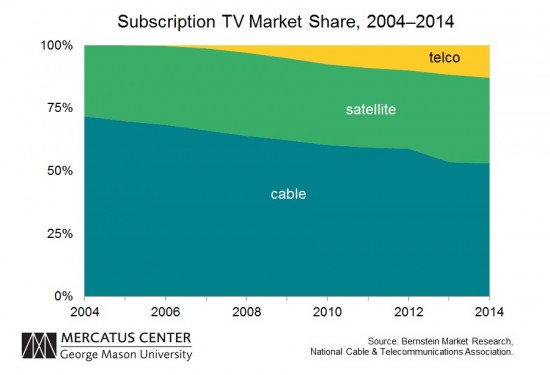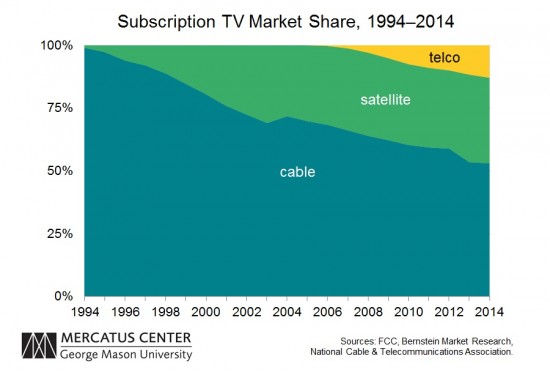Last Friday I attended a fascinating conference hosted by the Duke Law School’s Center for Innovation Policy about television regulation and competition. It’s remarkable how quickly television competition has changed and how online video providers are putting pressure on old business models.
I’ve been working on a project about competition in technology, communications, and media and one chart that stands out is one that shows increasing competition in pay television, below. Namely, that cable providers have lost nearly 15 million subscribers since 2002. Cable was essentially the only game in town in 1990 for pay television (about 100% market share). Yet today, cable’s market share approaches 50%. This competitive pressure accounts for some cable companies trying to merge in recent years.
Much of this churn by subscribers was to satellite providers but it’s the “telephone” companies providing TV that’s really had a competitive impact in recent years. Telcos went from about 0% market share in 2005 to 13% in 2014. This new competition can be tied to Congress finally allowing telephone companies to provide TV in 1996. However, these new services didn’t really get started until a decade ago when 1) digital and IP technology improved, and 2) the FCC made it clear by deregulating DSL ISPs that telephone companies could expect a market return for investing in fiber broadband nationwide.
UPDATE:
And below is market share data going back ten more years to 1994 using FCC data, which uses a slightly different measurement methodology (hence the kink around 2003-2004). I’ve also omitted market share of Home Satellite Dish (those large dishes you sometimes see in rural areas). Though HSD has negligible market share today, it had a few million subscribers in the mid-1990s. I may add HSD later.



 The Technology Liberation Front is the tech policy blog dedicated to keeping politicians' hands off the 'net and everything else related to technology.
The Technology Liberation Front is the tech policy blog dedicated to keeping politicians' hands off the 'net and everything else related to technology.